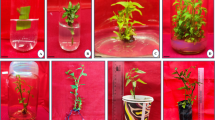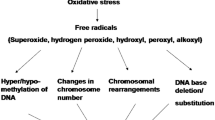Abstract
An F1 population consisting of 51 genotypes, derived from two unresponsive parental lines ofSolanum chacoense Bitt., was examined for shoot regeneration from leaf explants. Fourteen genotypes failed to respond whereas, among the responsive genotypes, four produced multiple shoots on over 90% of the explants. Estimates of broad-sense heritability were high for both frequency of responsive explants (83%) and the number of shoots per responsive explant (82%). The segregation of the F1 hybrid progeny was in agreement with the theoretical ratios of a genetic model for tissue culture responsiveness involving three unlinked genes. This study confirms earlier findings concerning the genetic control ofin vitro shoot regeneration from leaf explants inS. chacoense.
Similar content being viewed by others
References
Birhman RK, Laublin G & Cappadocia M (1994) Genetic control ofin vitro shoot regeneration from leaf explants inS. chacoense Bitt. Theor. Appl. Genet. 88: 535–540
Cloutier S, Cappadocia M & Landry B (1995) Study of microspore-culture responsiveness in oilseed rape (Brassica napus L.) by comparative mapping of a F2 population and two microspore-derived populations. Theor. Appl. Genet. 91: 841–847
Coleman M, Waugh R & Powell W (1990) Genetical analysis ofin vitro cell and tissue culture response in potato. Plant Cell Tiss. Org. Cult. 23: 181–186
Dathe U & Wersuhn G (1990) Temporary chromosome number stabilization in potato cell cultures. Plant Cell Tiss. Org. Cult. 22: 43–47
De Block M (1988) Genotype-independent leaf disc transformation of potato (Solanum tuberosum) usingAgrobacterium tumefaciens. Theor. Appl. Genet. 76: 767–779
De Block M (1993) The cell biology of plant transformation: current state, problems, prospects and the implications for plant breeding. Euphytica 71: 1–14
Düring K, Porsch P, Flading M & Lörz H (1993) Transgenic potato plants resistant to the phytopathogenic bacteriumErwinia carotovora. The Plant Journal 3: 587–598
Fish N & Jones MGK (1988) A comparison of tissue culture response between related tetraploid and dihaploidS. tuberosum genotypes. Plant Cell Tiss. Org. Cult. 15: 201–210
Henry Y, Vain P & De Buyser J (1994) Genetic analysis ofin vitro plant tissue culture responses and regeneration capacities. Euphytica 79: 45–58
Hulme JS, Higgins ES & Shield R (1992) An efficient genotype-independent method for regeneration of potato plants from leaf tissue. Plant Cell Tiss. Org. Cult. 31: 161–167
Jacobsen E (1981) Polyploidization in leaf callus tissue and in regenerated plants of dihaploid potato. Plant Cell Tiss. Org. Cult. 1: 77–84
Johnson HW, Robinson HF & Comstock R (1955) Estimates of genetic and environmental variability in soybeans. Agronomy J. 47: 314–318
Karp A, Risiott R, Jones MGK & Bright SWJ (1984) Chromosome doubling in monohaploid and dihaploid potatoes by regeneration from cultured leaf explants. Plant Cell Tiss. Org. Cult. 3: 363–373
Kumar A, Miller M, Whitty P, Lyon J & Davie P (1995)Agrobacterium- mediated transformation of five wildSolanum species usingin vitro microtubers. Plant Cell Rep. 14: 324–328
Mather K & Jinks JL (1982) Biometrical Genetics. Chapman and Hall, London
Murashige T & Skoog F (1962) A revised medium for rapid growth and bioassay with tobacco tissue cultures. Physiol Plant. 15: 473–497
Rivard SR, Saba-El-Leil MK, Landry B & Cappadocia M (1994) RFLP analyses and segregation of molecular markers in plants produced byin vitro anther culture, selfing, and reciprocal crosses of two lines of self-incompatibleSolanum chacoense. Genome 37: 775–783
Rivard SR, Cappadocia M & Landry B (1996) A comparison of RFLP maps based on anther-derived, selfed and hybrid progenies ofSolanum chacoense. Genome (in press)
Singsit C & Veilleux RE (1989) Intra-and interspecific transmission of androgenetic competence in diploid potato species. Euphytica 43: 105–112
Snedecor GW (1968) Statistical Methods. Iowa State College Press, Ames, Iowa
Sonnino A, Iwanaga M & Henostroza A (1988) Chromosome number doubling of 2x potato lines with diverse genetic background through tissue culture. Potato Res. 31: 627–631
Sonnino A, Tanaka S, Iwanaga M & Shilde-Rentschler L (1989) Genetic control of embryo formation in anther culture of dihaploid potatoes. Plant Cell Rep. 8: 105–107
Tavazza R, Tavazza M, Ordas RJ, Ancora G & Benvenuto E (1988) Genetic transformation of potato (Solanum tuberosum): an efficient method to obtain transgenic plants. Plant Sci. 59: 175–181
Taylor TE & Veilleux RE (1992) Inheritance of competencies for leaf disc regeneration, anther culture and protoplast culture inSolanum phureja and correlations among them. Plant Cell Tiss. Org. Cult. 31: 95–103
Uijtewaal BA, Jacobsen E & Hermsen JGTh (1987) Morphology and vigour of monohaploid potato clones, their corresponding homozygous diploids and tetraploids and their heterozygous parent. Euphytica 36: 745–753
Véronneau H, Lavoie G & Cappadocia M (1992) Genetic analysis of anther and leaf disc culture in two clones ofSolanum chacoense Bitt. and their reciprocal hybrids. Plant Cell Tiss. Org. Cult. 30: 199–209
Visser RGH, Jacobsen E, Hesseling-Meinders A, Schans, MJ, Witholt B & Feenstra WJ (1989) Transformation of homozygous diploid potato withAgrobacterium tumefaciens binary vector by adventitious regeneration on leaf and stem segments. Plant Mol. Biol. 12: 329–337
Webb JK, Osifo EO & Henshaw G (1983) Shoot regeneration from leaflet discs of six cultivars of potato (Solanum tuberosum subsptuberosum). Plant Sci. Lett. 30: 1–8
Wenzel G & Uhrig H (1981) Breeding for nematode and virus resistance in potato via anther culture. Theor. Appl. Genet. 59: 333–340
Author information
Authors and Affiliations
Rights and permissions
About this article
Cite this article
Van Sint Jan, V., Laublin, G., Birhman, R.K. et al. Genetic analysis of leaf explant regenerability inSolanum chacoense . Plant Cell Tiss Organ Cult 47, 9–13 (1996). https://doi.org/10.1007/BF02318960
Received:
Accepted:
Issue Date:
DOI: https://doi.org/10.1007/BF02318960




